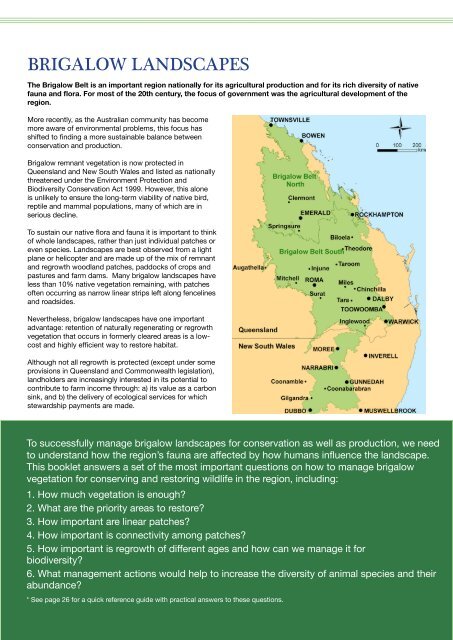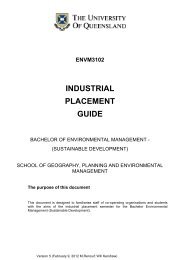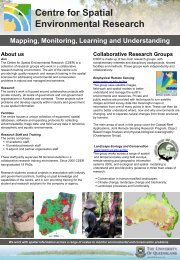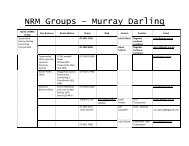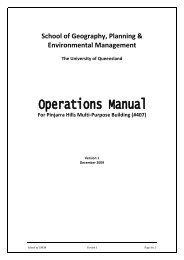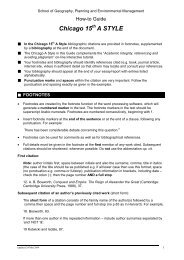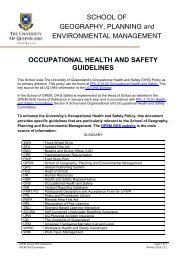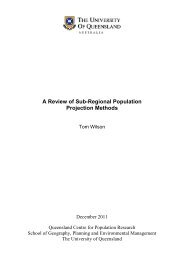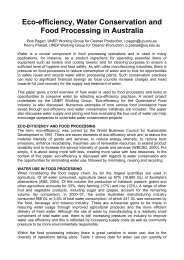Conserving Biodiversity in Brigalow Regrowth - School of ...
Conserving Biodiversity in Brigalow Regrowth - School of ...
Conserving Biodiversity in Brigalow Regrowth - School of ...
You also want an ePaper? Increase the reach of your titles
YUMPU automatically turns print PDFs into web optimized ePapers that Google loves.
<strong>Brigalow</strong> Landscapes<br />
The <strong>Brigalow</strong> Belt is an important region nationally for its agricultural production and for its rich diversity <strong>of</strong> native<br />
fauna and flora. For most <strong>of</strong> the 20th century, the focus <strong>of</strong> government was the agricultural development <strong>of</strong> the<br />
region.<br />
More recently, as the Australian community has become<br />
more aware <strong>of</strong> environmental problems, this focus has<br />
shifted to f<strong>in</strong>d<strong>in</strong>g a more susta<strong>in</strong>able balance between<br />
conservation and production.<br />
<strong>Brigalow</strong> remnant vegetation is now protected <strong>in</strong><br />
Queensland and New South Wales and listed as nationally<br />
threatened under the Environment Protection and<br />
<strong>Biodiversity</strong> Conservation Act 1999. However, this alone<br />
is unlikely to ensure the long-term viability <strong>of</strong> native bird,<br />
reptile and mammal populations, many <strong>of</strong> which are <strong>in</strong><br />
serious decl<strong>in</strong>e.<br />
To susta<strong>in</strong> our native flora and fauna it is important to th<strong>in</strong>k<br />
<strong>of</strong> whole landscapes, rather than just <strong>in</strong>dividual patches or<br />
even species. Landscapes are best observed from a light<br />
plane or helicopter and are made up <strong>of</strong> the mix <strong>of</strong> remnant<br />
and regrowth woodland patches, paddocks <strong>of</strong> crops and<br />
pastures and farm dams. Many brigalow landscapes have<br />
less than 10% native vegetation rema<strong>in</strong><strong>in</strong>g, with patches<br />
<strong>of</strong>ten occurr<strong>in</strong>g as narrow l<strong>in</strong>ear strips left along fencel<strong>in</strong>es<br />
and roadsides.<br />
Nevertheless, brigalow landscapes have one important<br />
advantage: retention <strong>of</strong> naturally regenerat<strong>in</strong>g or regrowth<br />
vegetation that occurs <strong>in</strong> formerly cleared areas is a lowcost<br />
and highly efficient way to restore habitat.<br />
Although not all regrowth is protected (except under some<br />
provisions <strong>in</strong> Queensland and Commonwealth legislation),<br />
landholders are <strong>in</strong>creas<strong>in</strong>gly <strong>in</strong>terested <strong>in</strong> its potential to<br />
contribute to farm <strong>in</strong>come through: a) its value as a carbon<br />
s<strong>in</strong>k, and b) the delivery <strong>of</strong> ecological services for which<br />
stewardship payments are made.<br />
To successfully manage brigalow landscapes for conservation as well as production, we need<br />
to understand how the region’s fauna are affected by how humans <strong>in</strong>fluence the landscape.<br />
This booklet answers a set <strong>of</strong> the most important questions on how to manage brigalow<br />
vegetation for conserv<strong>in</strong>g and restor<strong>in</strong>g wildlife <strong>in</strong> the region, <strong>in</strong>clud<strong>in</strong>g:<br />
1. How much vegetation is enough?<br />
2. What are the priority areas to restore?<br />
3. How important are l<strong>in</strong>ear patches?<br />
4. How important is connectivity among patches?<br />
5. How important is regrowth <strong>of</strong> different ages and how can we manage it for<br />
biodiversity?<br />
6. What management actions would help to <strong>in</strong>crease the diversity <strong>of</strong> animal species and their<br />
abundance?<br />
6<br />
* See page 26 for a quick reference guide with practical answers to these questions.


